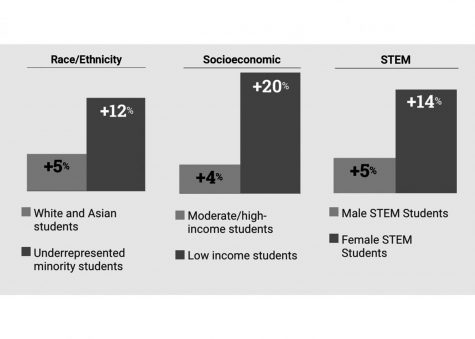Changes in the World of AP
If you’re taking an AP class this year, you may have noticed some differences from last year’s timeframe. College Board has rolled out a variety of changes that they believe will improve performance and participation in AP exams. Here’s the breakdown.
The first key modification was their decision to have students register and pay for their AP tests in the fall. The deadline for registration for tests last year was February 25th, while this year it was September 27th. This is a big jump, moving up the date by almost five months.

According to the College Board website, this was based on a pilot program with 40,000 students in which they saw an overall seven percent increase in passing scores on exams. For students in minority groups, the jump in scores was even greater (see graph for specific figures). Students in underrepresented minority groups saw a 12% increase, low-
income students saw a 20% increase, and girls in STEM saw a 14% increase. In interviews with teachers who participated in the program, students were said to be “engaged, confident, and less likely to give up.” One AP Physics teacher said that he appreciated how the early registration pushed his students to “buy in from the very first week.”
It is still too early to see if these will be the results at Boulder High, but not all of our teachers agree with the College Board. Mr. Wright, an AP English Language and Composition teacher at Boulder High, said that “the issue for us, at least in language arts, is that we are already scoring at a very high level compared to the state, the country, and the world.” 67% of Boulder High students that took the AP Lang and Comp test last year scored a four or a five. Comparatively, 29% of students in Colorado and 28% of students globally scored above a 3. This means that our commitment and passing scores aren’t exactly a problem that needs to be solved.
The second significant change College Board has made this year is rolling out their own online resources for students taking AP classes. AP Classroom provides instructional tools for teachers as well as review materials for students. Sign-up occurs on a class-by-class basis, so students see personalized content and deadlines that their teacher can set. Additionally, teachers can utilize the online practice to see where their class is performing on a set timeline. Mr. Wright said, “I appreciate that a large bank of questions and texts has been made available to us, though the interface is still clunky in early stages.”
Another resource given to teachers this year is a revised course and exam description (CED) for most classes. According to the College Board, the content in these binders includes an outline of the exact content and skills covered on the exam, ways of pacing and sequencing suggestions to help teachers integrate material into their courses, and unit-weighting to focus instruction on topics that will make the biggest impact.
College Board is confident that the combination of changes they made to the AP curriculum this year will have tangible effects in the spring. The hope is that through requiring early registration and providing new resources to students and teachers, AP classes can be more effective at preparing students for their exams, as well as college. It remains to be seen whether the impacts seen in the pilot program will extend to everyone participating this year, especially high-performing schools like Boulder High.

